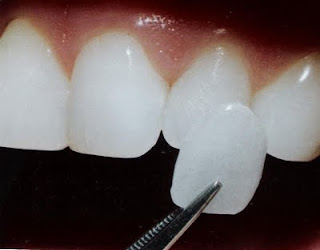Veneers are mademainly to improve the esthetics of the teeth, from the prosthetic point of view, they are partial lip crowns. Veneers are usually madefrom porcelain. There are also veneers madeof plastic, but they do not provide such a good cosmetic effect.
Materials currently used to perform veneers are porcelain, zircon, acrylics, composites. Ceramic veneers are virtually indistinguishable from natural teeth, in addition to having excellent the smoothest surface of all the materials used in prosthetics, which hinders the adhesion of bacteria and the production of dental plaque. Zirconium is considered the most biocompatible material used in prosthetic dentistry.
Veneers are desirable mostly in the following cases:
• correction of the shape of teeth
• occurrence of stubborn stains, such as after treatment with tetracyclines, root canal treatment or after fluorozach
• incisal fracture due to injury
• fracture of permanent teeth at an early age
• closing stems (gaps between teeth), especially aesthetics
• dental hypoplasia (dysplasia)
• extensive damage to the enamel by erosion / mechanical injury
• presence of large cervical restorations
Contraindications against veneers:
• parafunctions of chewing, such as teeth grinding, habitual clenching of teeth
• too large fillings
• prone to tooth decay or the presence of active caries
• too short teeth
• oral hygiene not sufficient enough
Diagnosis and Treatment Plan
Prior to the veneers, the dentist needs to perform a dental consultation and x-rays to exclude the presence of caries. It is advisable to treat caries and remove the tartar, if they are present. It is preferred to take photos before treatment and after its completion, in order to avoid any possible misunderstandings, in addition to objectively assess the treatment effect.
Preparation of the tooth and its cementing
Preparation of the tooth needs an anesthesia performed on the patient and retraction of the gums. The next step is to collect tissue from the labial surface of the crown - typically grinding is carried out exclusively in the enamel. The tooth surfaces is prepared taking into account the material from which the veneer will be made.
During the entire procedure water is used for cooling, which prevents overheating of the tooth, especially the pulp. After preparing the impressions of silicone are taken, which allow for very accurate representation of the surface. The polished tooth is secured by a temporary supplement which prevents the formation of hypersensitivity.
The impression is sent to a laboratory where a plaster model is made and on its basis the veneer is prepared. The dentist's office assesses the supplement and makes changes if neccessary. Then the veneer is cemented to the previously prepared tooth. A well-made veneer is virtually impossible to distinguish from a natural tooth.



No comments:
Post a Comment